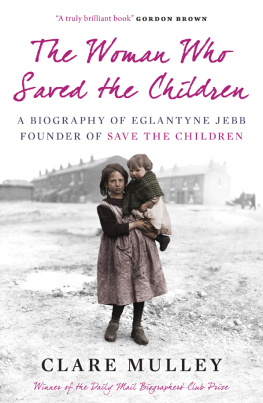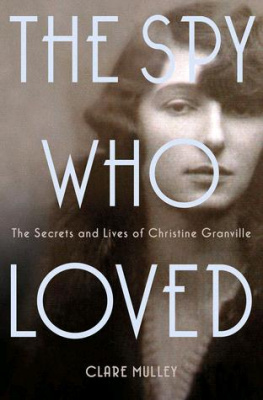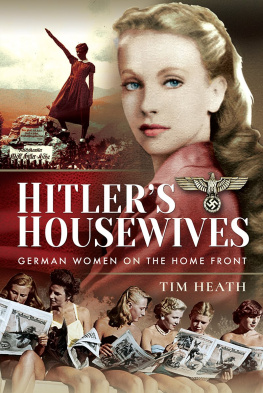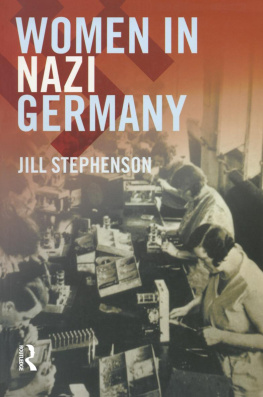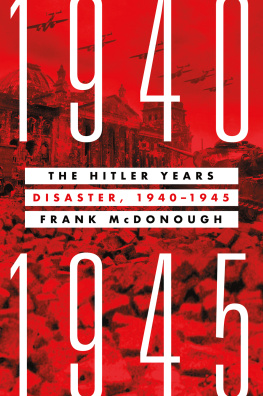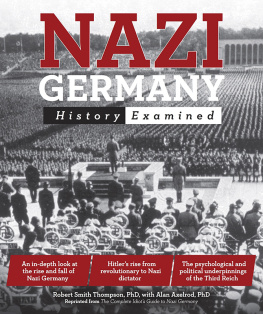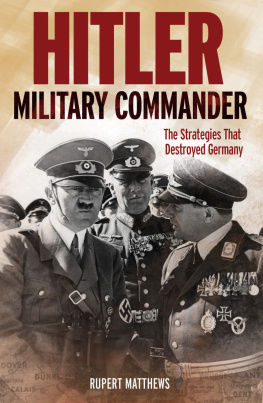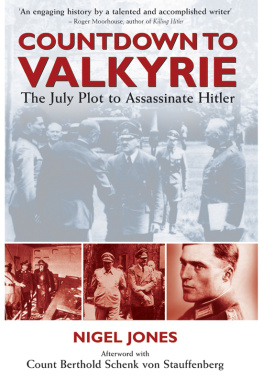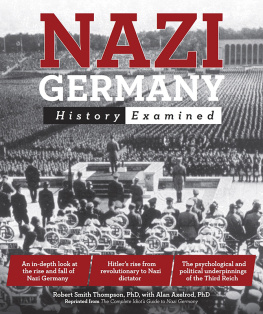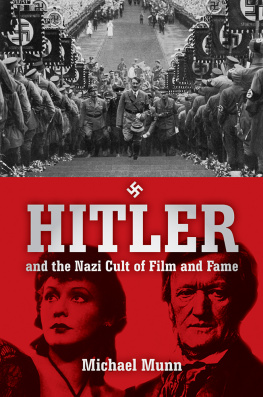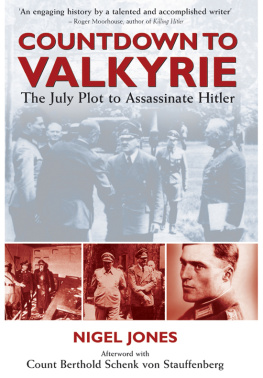CLARE MULLEY
THE WOMEN
WHO FLEW FOR
HITLER
The True Story of Hitlers Valkyries
MACMILLAN
For my inspirational sister, Kate Mulley,
whose dry humour masks a warm heart.
Contents
Acknowledgements
One of the wonderful things about researching a biography is the sense you sometimes have of shaking hands or joining a conversation across history. Reading diaries and letters, or even less intimate material, can bring moments of profound empathy and a frequent sense of a meeting of minds, but also the sudden shock of finding inexplicable prejudice, or worse. It is important not to assume too much understanding, or forget what might be lost in translation across language, time or context. Occasionally there is a more literal shaking of hands when meeting veterans, survivors or other witnesses for interviews. Several times while researching this book I found myself just a couple of handshakes away from Hitler, bearing in mind that not everyone who took his hand did so enthusiastically. Meeting people in rooms displaying photographs of their parents decorated with the Iron Cross or conducting the Nazi salute has proved particularly interesting. Decisions and actions were rarely as clear-cut at the time as seventy years distance might sometimes suggest, and reaching the many truths of any life, whether factual, moral or emotional, requires empathy as well as inquiry, criticism as well as care, and a respect for the absences from the record as well as for the traces left behind.
This book could not have been written without the very generous support of so many people who knew Melitta Schiller von Stauffenberg, Hanna Reitsch and their circles. In Germany, I was delighted to meet several members of Melitta and her in-laws families. Her nephew Dr Reinhart Rudershausen, and his wife Elke, generously gave me full access to their collection of family papers at their beautiful lakeside cottage, and later sent me original family photographs. Heidimarie Schade recalled childhood memories, including the time she scoffed Melittas Luftwaffe-issue chocolate, and her brother, Friedrich Berkner, also kindly shared all he knew. Major General Count Berthold von Stauffenberg, Claus von Stauffenbergs eldest son, spent a morning reminiscing about his family over and after a very fine breakfast. Thanks are also due to his sister, Konstanze von Schulthess-Rechberg, who recalled memories of her mother. Hendrik de Waal and his sister Katinka de Waal kindly shared a photograph of their uncle, Melittas dear friend, Friedrich Franz Amsinck. Melittas first biographer, Gerhard Bracke, who has his own fascinating childhood memories of the war, came to know Melittas sister Klara well many years later. With extraordinary generosity, Gerhard gave me full access to his personal collection of recorded interviews, photographs and papers, including Melittas handwritten 1943 and 1944 diaries, and some fascinating unpublished letters from Hanna.
Although unable to meet Hannas family, I was lucky to interview several people who knew her. First among these was the remarkable officer and test pilot Captain Eric Winkle Brown, the most decorated pilot in the history of the Royal Navy. Over a series of conversations, Eric described to me how he partied with Hanna before the war, formally identified her with the authorities during its closing days, and stayed in touch with her intermittently thereafter. Through the wonderful help of Margaret Nelson and Virginia Rouslin in Canada, I was also able to interview Luftwaffe Flight Captain Dietrich Ptter, who knew Hanna during the war. Lance Corporal Walter Rehling sent me his memories of her while I was visiting Peenemnde. The last person to meet Hanna among those I interviewed was BBC producer John Groom, who kindly recalled interviewing her for The Secret War series in the late 1970s, including watching her fall from her chair when carried away describing the flight arc of the rocket-powered Messerschmitt Komet. John Martin Bradley, who has spent years photographing veterans for his Combat Pilots of WWII collection, generously shared his interview with Hein K. Gering who once saved Hanna from a mouse, and James Holland kindly shared the many interviews with veterans he has conducted and posted on his www.griffonmerlin.com Second World War forum website. Very excitingly, Ian Sayer generously sent me scans of his important private collection of Hannas unpublished post-war correspondence, which gave a fascinating new insight into her dogmatic character. Bernd Rosemeyer, son of the pilot Elly Beinhorn, and Barbara Pasewaldt, daughter of Luftwaffe Wing Commander Georg Pasewaldt, also kindly shared their parents perspectives on both pilots.
I am also indebted to several veterans who talked to me about the context of the times, such as RAF Flying Officer John Alan Ottewell, my friend and neighbour Wing Commander Len Ratcliffe and, through Graham Cowie at the RAF Cosford Museum, Flight Lieutenant Rusty Waughman and Flight Sergeant Jack Pragnell, who dropped bombs on Peenemnde during Operation Hydra while Hanna reportedly slept through the raid below. WAAF Intelligence Officer, Doreen Galvin, and both my parents, Gill and Derek Mulley, were also kind enough to share their wartime memories with me. I sincerely thank them all.
Among others who helped to shape this book are the historian Heiko Peter Melle, who took me round the Stauffenberg schloss, and author and curator Anne Voorhoeve, who showed me much of Melittas Berlin. UCLs Professor Bernhard Rieger kindly shared his research on Hanna after the war; Caroline Esdaile the Kristallnacht memories of her father, Simon Reiss; and Chris Butler his family papers about Hitlers bunker in the first days of the peace. I must also particularly thank the historians and authors Nigel Jones and Paul Strong, conversations with whom led me to these womens stories, and Roger Moorhouse and Nick Jackson, who later generously helped to keep me on track in various archives and bars in London, Berlin and Munich.
My sincere thanks are also due to the archivists and staff at the British National Archives; the Imperial War Museum archives; the RAF Museum, Hendon; the British Library; the Deutsches Museum archive, Munich; the Technical University of Munich archives; the German Resistance Museum at the Bendlerblock, Berlin; the Pltzensee Prison Memorial Centre, Berlin; the Historical Technical Museum, Peenemnde; the US National Archives and Records Administration; Cornell University Law Library, Donovan Nuremberg Trials Collection; Alexander Historical Auctions; Hermann Historica International Auctions; Clint Daniel at the C. E. Daniel Collection; and the team at the Aerodrome de Gandalou, France, who bravely took me up in a glider and pretty quickly brought me back down again.
Ian Wolter and Kate Mulley thank you for everything, you are both marvellous. Heartfelt thanks also to my brilliant editor, George Morley, Tania Wilde, Philippa McEwan and the rest of the team at Macmillan publishers, and my agent, Andrew Lownie. Also to all those who very kindly helped to locate and translate books, archive material and even at times rather torturous poetry: Marie Frg, Barbara Schlussler, Wolfgang Gehlen, Karin Fischer-Buder, Stephanie Holl-Trieu, Paul Skinner and Hans Fliri, as well as to my valiant readers, Alison Mable and Michelle Wheeler. Finally, it is with great pleasure that I thank my three daughters, Millie and Flo for pointing out appropriate references from their own reading of Anne Frank and Robert Harris, and Hester for much needed encouragement and distractions. Any errors are, of course, my own. Thank you all.
C LARE M ULLEY , February 2017
Note on Spellings and Place Names
To assist the reader, whenever an unfamiliar German word is first mentioned, it will be in italics followed by an English translation. Thereafter, it will be in Roman. More anglicized German words, such as hausfrau and frulein, appear in Roman throughout. German spellings use ss rather than eszett for readability, so strasse rather than strae. Place names are as they were at the time, and within their contemporary borders, but with a footnote giving their modern equivalent and location when first mentioned.
Next page

